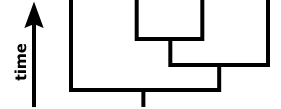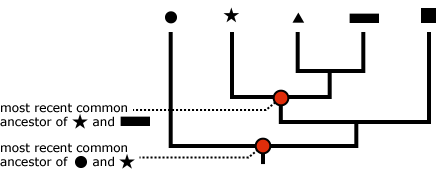While evolutionary trees are a useful way of conveying complex information in a visual format, they are also frequently misunderstood. To avoid the most common confusions, keep the following hints in mind when you see a phylogenetic tree:
- Time runs from the root to the tips of a tree, not across its tips. It’s easy to imagine that some terminal taxa are the ancestors of others, but this is simply not true. Terminal taxa share common ancestors with one another; to draw an analogy from genealogy, their relationship is that of cousins, not that of parent and child. For example, chimpanzees and humans are both terminal taxa — meaning that we are evolutionary cousins and that chimpanzees are not our ancestors, despite what some might think.

- The branching pattern of a tree indicates relatedness; taxa that share more recent common ancestors are more closely related. It’s tempting to think that terminal taxa that are located more closely to one another on a phylogeny are more closely related evolutionarily, but this is not the way that it works. Study the tree below. The circle and star taxa are adjacent to one another, but their most recent common ancestor is actually near the base of the tree. The star and rectangle taxa are actually much more closely related than the circle and star taxa are because the star’s and rectangle’s most recent common ancestor is younger and occurs nearer the tips of the tree!

- Trees depict evolutionary relationships, not evolutionary progress. It’s easy to think that taxa that appear near one side of a phylogenetic tree are more advanced than other organisms on the tree, but this is simply not the case. First, the idea of evolutionary “advancement” is not a particularly scientific idea. There is no unbiased, universal scale for “advancement.” Second, taxa with extreme versions of traits (which might be perceived as more “advanced”) may occur on any terminal branch. The position of a terminal taxon is not an indication of how adaptive, specialized, or extreme its traits are.

One tool for combating such misconceptions is the notion of branch rotation. As shown in the trees below, it’s possible to rotate branches around nodes without changing the evolutionary relationships depicted. This has the effect of changing the order of terminal taxa, but not changing the information that the tree conveys. Imagine the phylogenetic tree as a child’s mobile hanging from its root. As the wind blows and the mobile rotates, which branches are adjacent to one another may change, but the fundamental connections on the tree (the patterns of shared ancestry) do not. When faced with a tree that lends itself to notions of progress or other misconceptions, try rotating a few branches. Often, that exercise will demonstrate that a misleading interpretation must be wrong! Click here for more details on common misconceptions related to phylogenetics.

Despite such challenges, evolutionary trees can be readily understood by students and laypeople with just a little background information. The undertaking is well worth the effort. Evolutionary trees are a key tool of modern biology (which you can read more about in our section on how trees are used) and are increasingly likely to be found in textbooks, popular science publications, and museum exhibits. Furthermore, evolutionary trees convey not just information about relationships among individual taxa, but also communicate the fundamental message of evolutionary history: the fact of common ancestry. Life on Earth is diverse, and it’s easy to focus on the traits that distinguish us from other species. However, phylogenies emphasize the flipside of that coin, the unifying bonds of genetic inheritance and shared ancestry that make us all family — evolutionary cousins on the great tree of life.
